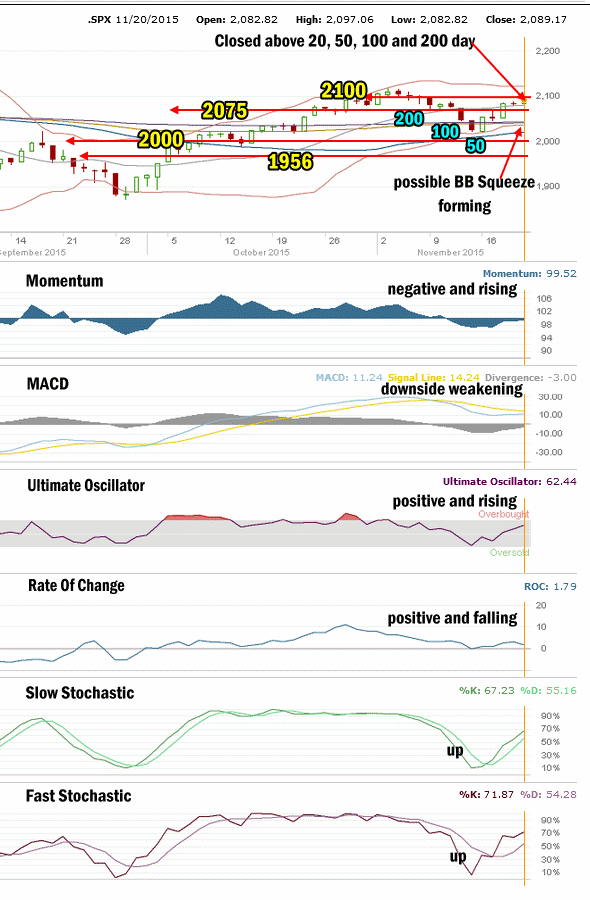Friday’s market direction up stalled during the day and spent much of the day sliding lower after reaching 2097. By the close the S&P was still up 7.93 points to close at 2,089.11 on Friday.
Advance Decline Numbers
Volume was higher on Friday by 300 million shares to 3.9 billion.
Of that volume 51% was to the downside. New lows were down slightly from Thursday to 122 but they still swamped new highs which came in at 74. New highs were still up from Thursday’s 48.
The NASDAQ saw up volume unchanged on Friday at 1.7 billion shares traded. 67% of all volume was traded to the upside which was better than the S&P. New lows fell again on Friday from 101 on Thursday to 74 on Friday. New highs rose slightly from 66 to 72.
The advance decline numbers show a market stuck sideways at present but that should change on Friday.
Market Direction Closings
The S&P closed at 2,089.17 up 7.93. The DOW closed at 17,823.81 up 91.06. The NASDAQ closed at 5104.92 up 31.28.
Market Direction Technical Indicators At The Close of Nov 20 2015

SPX Market Direction Technical Analysis to Nov 20 2015
Stock Chart Comments:
The S&P closed on Friday still above all three major moving averages and the 20 day simple moving average (SMA).
The 100 day moving average is now ready to move above the 200 day. This could happen on Monday which would be a strong up signal if the 100 day continued higher. Meanwhile The Lower Bollinger Band is still moving above the 50 day moving average which is a bearish signal and at the same time the Bollinger Bands look like they may be starting to form a Bollinger Bands Squeeze.
As well the closing candlestick on Friday was bearish for stocks which could point to a lower start to the week on Monday.
Support and Resistance Levels:
These are the present support and resistance levels.
2100 was light support. Stocks have been unable to stay above this level and push higher on numerous occasions. It remains resistance.
2075 is light support. Below that is 2050 which is light support. Stronger support is at 2000 which had repeatedly held the market up throughout each pullback in January and February but failed under the waves of selling in the last correction. Stocks continue to have trouble holding the 2000 level.
Weak support is at 1970 while stronger support is at 1956 and technically it is more important than 1970 for the market. 1940 is light support. 1920 is now light support. 1900 is more symbolic than anything else.
1870 and 1840 are both levels with strong enough support to delay the market falling and should see a sideways action attempt while investors decide whether to sell or buy. So far 1870 has held the market up better than any of the other support levels aside from 2000 which held the market up for months before the collapse in August.
The other two support levels are 1775 and 1750. I have explained that these two are critical support for the present bull market. While 1775 is important it is 1750 that is the bottom line.
A break of 1750 would mark a severe correction of 384.72 points or 18% from the all-time high of 2134.72. This would be the biggest correction since April 2012. A pull-back of that size would definitely stun investors and bring to question whether the bull market is finished.
Momentum: For momentum I use a 10 period when studying market direction. Momentum is negative and rising.
MACD Histogram: For MACD Histogram, I am using the Fast Points set at 13, Slow Points at 26 and Smoothing at 9. MACD (Moving Averages Convergence / Divergence) issued a sell signal on Friday Nov 10. That sell signal is weakening.
Ultimate Oscillator: The Ultimate Oscillator settings are: Period 1 is 5, Period 2 is 10, Period 3 is 15, Factor 1 is 4, Factor 2 is 2 and Factor 3 is 1. These are not the default settings but are the settings I use with the S&P 500 chart set for 1 to 3 months. The Ultimate Oscillator is back positive and rising higher.
Rate of Change: Rate Of Change is set for a 21 period. The rate of change signal is positive but falling back.
Slow Stochastic: For the Slow Stochastic I use the K period of 14 and D period of 3. The Slow Stochastic tries to predict the market direction further out than just one day. The Slow Stochastic is signaling up for stocks.
Fast Stochastic: For the Fast Stochastic I use the K period of 20 and D period of 5. These are not default settings but settings I set for the 1 to 3 month S&P 500 chart when it is set for daily. The Fast Stochastic is also signaling higher for stocks but you can see in the chart that while the signal is still bullish, the %K signal line has turned considerably lower.
Market Direction Outlook for Nov 23 2015
For Monday the technical indicators are 4 positive and 2 negative. Of the positive indicators one, the rate of change, is turning lower. Overall though the market still looks like it will move higher.
Monday could see some weakness as the closing candlestick reflected, but even if Monday is lower in the morning I would expect a push back in the afternoon and a positive close.
It is a short week and historically the week leading to Thanksgiving is strong for stocks. I am expecting a move higher by the close on Monday.
Stay FullyInformed With Email Updates
Market Direction Internal Links
Profiting From Understanding Market Direction (Articles Index)
Understanding Short-Term Signals
Market Direction Portfolio Trades (Members)
Market Direction External Links
IWM ETF Russell 2000 Fund Info
Market Direction SPY ETF 500 Fund Info
